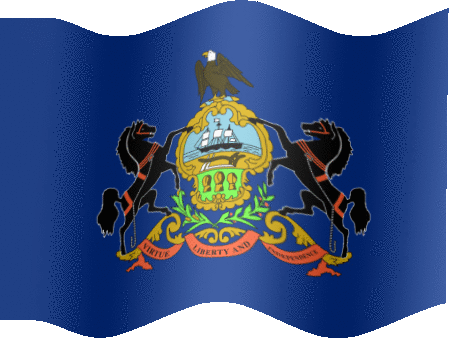Pennsylvania . . . State 2
Pennsylvania's official flag was adopted in 1907. The flag has a deep blue background on which the State Coat of Arms is embroidered. In the center are two harnessed draft horses surrounding a shield picturing a ship, a plow, and 3 sheaves of wheat and above a bald eagle rests. Below are a stalk of corn, an olive branch, and a draped red ribbon scroll that reads,"VIRTUE, LIBERTY, AND INDEPENDENCE."
The State of Pennsylvania became a US state on December 12, 1787 as the 2nd state. Pennsylvania is one of the Middle Atlantic states of the United States and is known as the Keystone state. It got this name back in the days when there were only 13 states. Pennsylvania was in the center with six to the north and east and six to the south. To the east is the Delaware River, which separates Pennsylvania from New York and New Jersey. To the southeast is Delaware and Maryland and West Virginia are to the south. To the west are West Virginia, south of the Ohio River, and Ohio, north of the Ohio River. In the northwest there is a border on Lake Erie for 51 miles. The remainder of the northern border is shared with New York.
Pennsylvania is a smaller state but has a large population with over 12 million residents. There are only 5 states with higher population, Texas, California, Illinois, Florida and New York. It’s main city, Philadelphia, is one of the largest cities in the country and a busy Atlantic port. It has a great water transportation system and has commercial water outlets on the Great Lakes, the Atlantic Ocean, and the Gulf of Mexico from the Ohio-Mississippi river system. This makes Pennsylvania a major industrial center.
Pennsylvania has long been a leading industrial state and leads the nation in iron, steel and coal. Many people visit Pennsylvania for the many cultural attractions and over 100 state parks. There are wonderful art museums, a professional orchestras, home of the Carnegie Science Center, and The Andy Warhol Museum and also many professional sports teams.
Pennsylvania Economy:
Agriculture: Dairy products,
poultry, cattle, nursery stock,
mushrooms, hogs, hay
Pennsylvania Industry: Food processing, chemical products, machinery, electric equipment, tourism
Pennsylvania is a mountainous state and enjoys four seasons which greatly differ based on location. Pennsylvania summers are long, hot and humid in the southeast, while in the mountains the days are generally cooler but humid. Fall is pleasant throughout the state and winter brings snow and much colder temperatures, especially in the mountains. January is the coldest month, with average high temperatures in the mid-20s. July is the warmest month, with average high temperatures near 80 degrees. Summer temps in the 90s are not uncommon in the southeast and southwest. Annual precipitation averages near 45 inches in the southeast and in the mountains, while lower amounts are common near its north-central border with New York State.
Pennsylvania has 67 counties:Adams Allegheny Armstrong Beaver Bedford Berks Blair Bradford Bucks Butler Cambria Cameron Carbon Centre Chester Clarion Clearfield Clinton Columbia Crawford Cumberland Dauphin Delaware Elk Erie Fayette Forest Franklin Fulton Greene Huntingdon Indiana Jefferson Juniata Lackawanna Lancaster Lawrence Lebanon Lehigh Luzerne Lycoming McKean Mercer Mifflin Monroe Montgomery Montour Northampton Northumberland Perry Philadelphia Pike Potter Schuylkill Snyder Somerset Sullivan Susquehanna Tioga Union Venango Warren Washington Wayne Westmoreland Wyoming York


